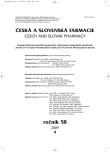-
Články
Top novinky
Reklama- Vzdělávání
- Časopisy
Top články
Nové číslo
- Témata
Top novinky
Reklama- Kongresy
- Videa
- Podcasty
Nové podcasty
Reklama- Kariéra
Doporučené pozice
Reklama- Praxe
Top novinky
ReklamaDetermination of the constituents of propolis of different geographical origin
Authors: J. Muselík 1; R. Masteiková 1; V. Suchý 2; Z. Chalupová 1; V. Ostrá 1
Authors place of work: Veterinární a farmaceutická univerzita Brno, Farmaceutická fakulta, Ústav technologie léků 1; Veterinární a farmaceutická univerzita Brno, Farmaceutická fakulta, Ústav přírodních léčiv 2
Published in the journal: Čes. slov. Farm., 2009; 58, 179-183
Category: Původní práce
Summary
The structural diversity of propolis constituents, due to a larger number of plant sources, is the cause of diverse composition and the hitherto unsolved standardization. The principal share in the biological effects is ascribed to flavonoids and aromatic acids and their derivatives. The results presented in this paper illustrate the diversity of the compositions of ten propolis samples obtained from different regions of the Czech Republic and three samples from abroad. Attention was paid to the determination of polyphenols, content of flavones and flavonols and the assay of antioxidative activity. The results confirmed the variability of the parameters under study as well as the presence of chrysin, galangin, p-coumaric, ferulic, cinnamic and benzoic acids in dependence on the area of collection. It will be difficult to elaborate a method of standardization suitable for possible administration of propolis preparations. In the future, propolis could become a raw material for the isolation of individual groups of biologically active substances.
Key words:
propolis – flavonoids – phenolic acids – antioxidative activity – liquid chromatography
Zdroje
1. Banskota, A. H., Tezuka, Y., Kadota, S.: Phytother. Res., 2001; 15, 561–571.
2. Lu, L. C., Chen, Y. W., Chou, C. C.: Int. J. Food Microbiol., 2005; 102, 213–220.
3. Borrelli, F. et al.: Fitoterapia, 2002; 73 Suppl. 1, 53–63.
4. Sawaya, A. C. H. F. et al.: Lett. Appl. Microbiol., 2002; 35, 203–207.
5. Moreira, L. et al.: Food Chem. Toxicol., 2008; 46, 3482–3485.
6. Sforcin, J. M.: J. Ethnopharmacol., 2007; 113, 1–14.
7. Banskota, A. H. et al.: Phytomedicine, 2001; 8, 16–23.
8. Gekker, G. et al.: J. Ethnopharmacol., 2005; 102, 158–163.
9. Lucrecia, L. et al.: Food Sci. Technol., 2009; 42 1422–1427.
10. Hegyi, E., Suchý, V., Nagy, M.: Hautarzt, 1990; 41, 675–679.
11. Hausen, B. M. et al.: Contact Dermatitis, 1987; 17, 163–170.
12. Hausen, B. M. et al.: Contact Dermatitis, 1987; 17, 171–177.
13. Bankova, V.: J. Ethnopharmacol., 2005; 100, 114–117.
14. Šmejkal, K. et al.: Molecules, 2007; 12, 1210–1219.
15. Trusheva, B., Trunkova, D., Bankova, V.: Chem. Cent. J., 2007; 1, 1–4.
Štítky
Farmacie Farmakologie
Článek vyšel v časopiseČeská a slovenská farmacie
Nejčtenější tento týden
2009 Číslo 4- Přerušovaný půst může mít významná zdravotní rizika
- Biomarker NT-proBNP má v praxi široké využití. Usnadněte si jeho vyšetření POCT analyzátorem Afias 1
- Pomůže AI k rychlejšímu vývoji antibiotik na kapavku a MRSA?
-
Všechny články tohoto čísla
- Standardní receptura pro přípravu léčivých přípravků v lékárnách III Některé možnosti využití isopropylalkoholu
- Kardioprotektivní efekt 2’,3,4’-trihydroxychalkonu v preklinickém experimentu
- Určení tloušťky obalu tvrdých hypromelosových tobolek pomocí blízké infračervené spektroskopie
- Úloha flavonoidu osajinu na modelu ischemie-reperfuze ledviny
- Vliv kombinovaného odnětí hormonů a houbového elicitoru na produkci kumarinů v suspenzní kultuře Angelica archangelica L.
- Studium vlastností tablet z přímo lisovatelného isomaltu
- XLIX. sympozium z historie farmacie a veterinární medicíny
- Stanovení obsahových látek propolisů různého geografického původu
- Z činnosti farmaceutických společností
- Na památku prof. RNDr. PhMr. Karla Paláta, CSc.
- Česká a slovenská farmacie
- Archiv čísel
- Aktuální číslo
- Informace o časopisu
Nejčtenější v tomto čísle- Standardní receptura pro přípravu léčivých přípravků v lékárnách III Některé možnosti využití isopropylalkoholu
- Stanovení obsahových látek propolisů různého geografického původu
- Studium vlastností tablet z přímo lisovatelného isomaltu
- Určení tloušťky obalu tvrdých hypromelosových tobolek pomocí blízké infračervené spektroskopie
Kurzy
Zvyšte si kvalifikaci online z pohodlí domova
Autoři: prof. MUDr. Vladimír Palička, CSc., Dr.h.c., doc. MUDr. Václav Vyskočil, Ph.D., MUDr. Petr Kasalický, CSc., MUDr. Jan Rosa, Ing. Pavel Havlík, Ing. Jan Adam, Hana Hejnová, DiS., Jana Křenková
Autoři: MUDr. Irena Krčmová, CSc.
Autoři: MDDr. Eleonóra Ivančová, PhD., MHA
Autoři: prof. MUDr. Eva Kubala Havrdová, DrSc.
Všechny kurzyPřihlášení#ADS_BOTTOM_SCRIPTS#Zapomenuté hesloZadejte e-mailovou adresu, se kterou jste vytvářel(a) účet, budou Vám na ni zaslány informace k nastavení nového hesla.
- Vzdělávání



